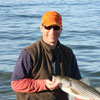Fly, Spin, & Conventional Surf Fishing Equipment Basics
By Tom Keer
Jan 04, 2018
The beauty of surf fishing is that it can be easy and simple. Grab your rod, reel, and some other gear basics and hit the sand.
Every year, millions of anglers hit the suds all around the country. Some catch redfish, snook, and jacks while others search for striped bass, bluefish or sea trout. Fishing equipment and techniques for surfing are different from those used inland, so let's have a look at some surf fishing equipment basics.
Surf Fishing Equipment Essentials
Plug and live bait rods should be between 10 and 12 feet long, in a medium-fast action, capable of throwing plugs and spoons between 1 and 3 ounces. Spin and conventional reels should hold plenty of line. 150 to 200 yards of 15-20 pound test mono is good, but if you need more line or a line of a higher pound test then switch to a braided mono. In cooler waters, waders or rubber knee boots are good on the beach but if it's warmer you can get away with sandals or wading boots. You'll need polarized glasses, stainless steel pliers or forceps, hook hones, swivels, snaps, three-way rigs, and leader material. Plugs, soft plastics, spoons and weights are commonly used surf fishing gear. If you're targeting toothy fish like bluefish then make sure that you have a lipper or a gripper in addition to your pliers.
Fly Fishing Rods
Next on the list for surf fishing equipment basics is Fly fishing rods. Fly rods in the 9 to 10 foot length for 9 or 10 weights are ideal for punching out long casts. Floating lines, intermediate lines, and full sinking lines are ideal for dropping flies at different levels of the water column. Leaders, terminal gear, scissor/forceps, hook hones, and scissors/forceps are easily stored in a chest pack. For flies, try a combination of attractors and imitators, with streamers, epoxies, bucktails, and a variety of poppers or sliders work for flies.
Surf Fishing Tips
Reading the water is important, so you'll need to learn about beaches, estuaries, coves, breakwalls, flats, and rips. Each of these areas hold fish on different phases of the tide. They provide structure that predators use to pin down their prey. Here are more Surf Fishing tips.
Know how to Fish while Surfing
To know how to fish while surfing you have to know in which direction the current moves. Fish swim into the current, and begin your search with where the tide and the wind connect. Baitfish holds in those areas, and where the bait is so are the fish.
Remember, whatever you carry down the beach you'll have to carry back to your rig. And that's why after fishing in the brine for decades many successful anglers stick to surf fishing equipment basics. Less is more!









